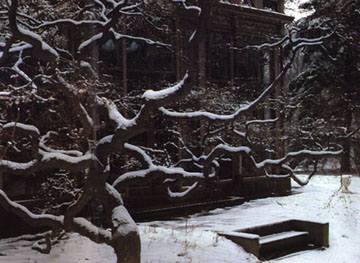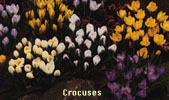
Gothic Gardening: Theme Gardens
The Garden in Winter

"Now is the winter of our discontent" could be said almost every winter
by a gardener. The sky is gray and dreary, the trees are merely the bones of
their branches, the earth is cold and the wind is icy. The garden exists in
its most skeletal form. If anyone were silly enough to pick the most 'gothic'
season, winter would win easily. No sunbathers, no heat (and no heatstroke
from wearing black), the days are blissfully short and the nights are
chillingly long. But even in winter, a well planned garden can be delightful.
With some forethought, you, too, can bundle up in your silks and velvets and
leathers and stroll about your winter garden....
Architecture
When all the lush greenery of summer is long gone, the architectural
elements of the garden become far more visible. Fences, arbors, paths and
walls all become very important visual elements. Well placed statuary provide
focal points for the eye. I can't tell you exactly how to construct your
garden, but remember to keep it somewhat simple, not garish. Make sure it
works within the confines of your garden space. Include the outlines of
trees, shrubs, and hedges when looking with a critical eye at your garden
architecture.
While I'm certainly not going to advocate filling your lawn with cement
geese or cutouts of little boys urinating, I can make a few suggestions
for ornamentation:
- Gargoyles
- The obvious choice. Of course, I should call them
grotesques rather gargoyles, since most I've seen don't function as
waterspouts (but who's going to be that picky?). Make sure to get them
made of an outdoor resin (pricey) or concrete (cheap). The one that is
easiest to find is the winged dog, but many places offer others such as
the gnawing or spitting gargoyles or dragons. Griffins and lions also
make excellent garden pieces. Design Toscano is expensive,
but has the best selection I've seen. There are also several places on
the web now which sell outdoor statuary.
- Gazing Globes
 I admit, when one of these red or blue colored
globes is sitting on a birdbath pedestal in the middle of the front
lawn of a trailer, it looks like nothing more than a huge christmas
ornament. However, these globes were beloved of the Victorians, who found
two uses for them. The first involved spying on, or rather, discreetly
chaperoning young couples strolling in the garden to make sure there they
weren't doing anything naughty. The second use was a bit more superstitious--
they were supposed to scare off witches, since witches would be horrified
by their reflection. A plain silver or deep burgundy globe could be tucked
into a corner of the garden.
I admit, when one of these red or blue colored
globes is sitting on a birdbath pedestal in the middle of the front
lawn of a trailer, it looks like nothing more than a huge christmas
ornament. However, these globes were beloved of the Victorians, who found
two uses for them. The first involved spying on, or rather, discreetly
chaperoning young couples strolling in the garden to make sure there they
weren't doing anything naughty. The second use was a bit more superstitious--
they were supposed to scare off witches, since witches would be horrified
by their reflection. A plain silver or deep burgundy globe could be tucked
into a corner of the garden.
- Garden Saints
- Several saints belong in the garden. St. Fiacre, a
7th century Irishman, is one of the patron saints of gardens (and for
some reason, also of taxicabs and relief from hemorrhoids). He became a
hermit in France, healing the sick. He was visited by so many people that
he asked the Bishop for more land; he was given as much land as he could
clear with his spade in one day. A host of angels came down from heaven
and helped him, and in commemoration of the miracle, he became the
patron saint of gardeners. Most statues of St. Fiacre are done in the
true gothic style. St. Phocas is the other patron saint of gardeners, and
lived in the 3rd century. He dug his own grave in his garden when the
lictors came to kill him because he was a Christian. St. Francis of Assisi
is also appropriate for the garden, since is a protector of animals. St.
Isadore is the patron saint of farmers. St. Dorothy is associated with
flowers.
- Green Man
| The Green Man is the male principle of fertility,
symbolizing renewal and resurrection, and is considered good luck in the
garden. His leafy image represents the guardian of the forest and all
green, growing things. Sometimes the foliage of his face is sculpted
accurately enough to identify the species of the plant. |  |
- Topiary
- Plants as sculpture! Many evergreen shrubs can be
selectively trimmed so that they are shaped into the desired form--just
don't go Disney. Also, evergreen vines such as ivy can be grown along
wire frames to make interesting shapes. Hmmm....perhaps a nice bat?
There are many more options for decorations. Wrought iron furniture,
or perhaps even a wrought iron gazebo, classical statues, heliochronometers
(the vaguely globe-like sundials), gothic stepping stones....
Showy Winter Plants
With so little green about, many plants offer interest from their bark
or shoots or berries, and a few still offer beautiful foliage.
- Willow
- A few willow species have lovely color during the winter. Salix alba 'Britzensis' has brilliant orange red shoots. This works best if
planted as a group, so there are many of these red twiggy shoots together. S. daphnoides has deep purple-plum bark, which would look nice against a
light background.
- Dogwood
| Similar to S. alba, Cornus alba has two varieties which put forth brilliant colored shoots during winter. 'Sibirica' has intense crimson
stems, and 'Kesselringii' has deep purple-black shoots. |  |
- Whitebark Birches
- There are many Betula species with the striking
white bark that make these popular. The Himalayan birch, B. utilis jacquemontii
is probably the whitest, with even the smallest branch being milky white. The
native north american paper birch, B. papgrifera, is more cream colored.
- Moosewood
- A native north american snakeskin maple, Acer pensylvanicum
has jade green bark striped with silver and white. The smallest branches
are green, slightly larger ones are reddish brown, and then the largest
branches and the trunk have the snakeskin pattern.
- Silk Tassel Bush
- Garrya elliptica is an evergreen shrub that forms
silvery jade green catkins in winter. Male plants have larger catkins than
the females.
- Holly
- There are many Ilex species, and these are thought of as a
traditional winter plants. One intriguing female variety is I. aquifolium
'Perry's Silver Weeping', which has leaves edged in silver and a "weeping"
habit.
- Skimmia
- Skimmia japonica has bright red berries all winter, which the
birds won't eat, and the variety 'Rubella' will form pink flower buds in
winter.
- False Castor-oil Plant
- Fatsia japonica has white flowers late in
autumn, which may last into winter, but in late winter form clusters of black
berries.
- Italian Arums
- The Arum italicum varieties have lovely marbled leaves
which appear in late autumn and last all winter, and early in winter they
are complemented by spikes of bright orange-red fruits.
- Bergenia
- These are semi-evergreen plants with leathery leaves. Bergenia cordifolia 'Purpurea' has leaves which turn magenta in winter, and B. purpurascens has dark reddish leaves.
There are also the "contorted" trees, such as Harry Lauder's
Walking Stick, which are so gnarled that their leafless branches are an
intriguing shape in the winter garden.
Winter Flowers
Nature is resourceful, and even during the cold, bleak days of winter,
some plants give forth blooms. Unlike the blooms of summer, these tend to
be smaller, less showy, and nodding, to protect them from the elements. This
list is by no means exhaustive.
- Hellebores
- These are very popular winter bloomers. Hellebore
atrorubrens blooms mid winter with dark maroon flowers, and at the same
time, the Christmas Rose, H. niger, has whitish blooms. Late in winter
the Lenten Rose, H. orientalis, blooms, with colors from creamy white to
darkest plum.
- Winter Aconite
- Eranthis hyemalis has late winter yellow blooms.
- Crocus
| There are many crocus species which bloom late in winter. Crocus chrysanthus 'Lady Killer' has white a purple-blue pointed petals. C.
tomasinianus 'Ruby Giant' has deep red-purple flowers. |  |
- Snowdrops
- All the Galanthus species have white flowers. A legend
from Germany says the snowdrop gave its color to the snow after all of
the other flowers refused to share their color. So the snow shelters the
flower and keeps it warm through the winter.
- Winter Heath
- There are many varieties of Erica carnea that bloom
throughout the winter, and many also have lovely plum or bronze colored
foliage.
- Algerian Iris
- Iris unguicularis has smallish lilac blooms throughout
winter.
- Winter Sweet
- Chimonathus praecox is a large shrub which flowers in
mid winter. The flowers have a grayish tint, and the petals are transparent.
- Winter Honeysuckle
- Lonicera standishii blooms early in winter, L.
fragrantissima blooms late. The flowers are creamy white.
- Witch Hazel
- A few Hamamelis species flower mid winter. H. japonica has
twisty yellow flowers. H. x intermedia 'Jelena' has yellow flowers which
are tinted coppery-red. Witch hazel rods have been used for water divining.
- Daphne
- Daphne mezereum is a deciduous shrub which has rosy purple
flowers on leafless branches in late winter. D. odora has glossy leaves and
red-purple flowers in mid winter.
- Winter Jasmine
- Jasminum nudiflorum has bright yellow flowers all winter.
- Viburnum
- The viburnums have clusters of flowers on leafless
branches
throughout the winter. Viburnum farreri is white; V. x bodnantense has pink
flowers.
There are many books written exclusively for winter (and for autumn)
gardening, and many garden planning books will have a special section for
winter plants. The winter has been a season long neglected by gardeners, but
definitely offers many possibilities.
Main Index
Gothic Gardening is copyright (c) 1995-1997
by Alice Day (mAlice).
All Rights Reserved.
--unless otherwise attributed--



 I admit, when one of these red or blue colored
globes is sitting on a birdbath pedestal in the middle of the front
lawn of a trailer, it looks like nothing more than a huge christmas
ornament. However, these globes were beloved of the Victorians, who found
two uses for them. The first involved spying on, or rather, discreetly
chaperoning young couples strolling in the garden to make sure there they
weren't doing anything naughty. The second use was a bit more superstitious--
they were supposed to scare off witches, since witches would be horrified
by their reflection. A plain silver or deep burgundy globe could be tucked
into a corner of the garden.
I admit, when one of these red or blue colored
globes is sitting on a birdbath pedestal in the middle of the front
lawn of a trailer, it looks like nothing more than a huge christmas
ornament. However, these globes were beloved of the Victorians, who found
two uses for them. The first involved spying on, or rather, discreetly
chaperoning young couples strolling in the garden to make sure there they
weren't doing anything naughty. The second use was a bit more superstitious--
they were supposed to scare off witches, since witches would be horrified
by their reflection. A plain silver or deep burgundy globe could be tucked
into a corner of the garden.


